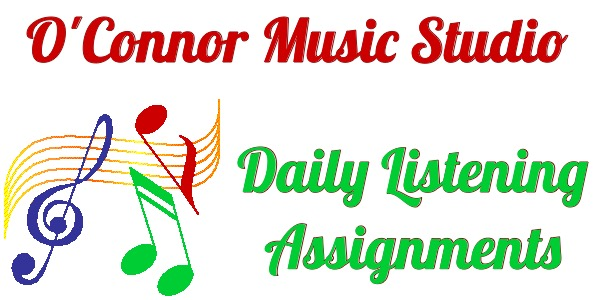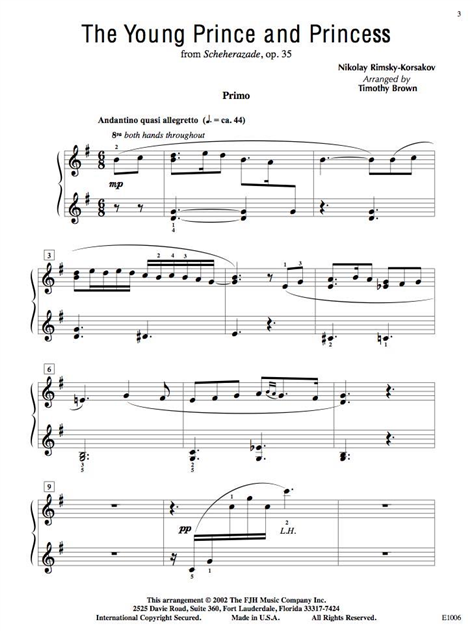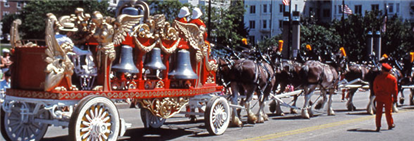Daily Listening Assignments ~ July 13, 2020
Monday, July 13, 2020 by Mary O'Connor | OCMS

Will you be going to the Circus this Summer?
Here's some information about circus music.
WINDJAMMERS
Circus marches are called "screamers" because they are traditionally so high, loud & fast!! Circus Band members are often called "windjammers" because they jam so much wind into their instruments in the process of playing these screamers. Playing the circus requires incredible endurance & skills on your instrument. The windjammers play almost none stop and much of the music is really difficult!
The greatest circus bands were about 100 years ago in the heyday of the circus. At that time the big top band could be 25 or so, plus there were often sideshow musicians as well. Cowboy bands, women's bands and bands of Blacks were often part of the sideshows.
Contemporary circuses are much smaller all the way around, and some don't use live musicians at all, just "canned" music (recordings). Others carry 3 musicians, a drummer, a trumpet player and a keyboard (synthesizer) player. A few, like the Big Apple Circus, still have bands. The Big Apple Circus has 8 musicians on its bandstand: a conductor/trumpet, a person who plays alto sax and clarinet, one who plays tenor sax and flute, a violin, a trombone, a bass player, a keyboard player and a drummer.
In the "old days," being a circus musician was one of the most strenuous jobs a musician could have. In the days before musicians' unions, the windjammer would be expected to play for the circus parade, play a pre-show free concert for the townspeople, ballyhoo around the grounds before the big top show, play the show itself (nonstop for two or three hours!), play post-show concerts on the grounds or play sideshows. Then after everyone left, they helped take down the tents or do other chores around the grounds. It was a busy day and the pay was not very good, but it was an exciting life with lots of great music, and many musicians loved it!
![]()
THE MUSIC
Entry of the Gladiators (Thunder and Blazes) was written in 1897 by, the Czechoslovakian composer, Julius Fucik (1872-1916). This march is a classic circus march & one that just about everyone will think, "Ah, circus!" when they hear it. Thunder and Blazes (as it is most frequently called) and Fucik's Florentiner March are probably his most well-known marches.
Most circus marches follow the standard American military march form, but often abbreviated (no repeats in the second half):
- Introduction (a bit longer than military marches)
- First strain (repeated)
- Second strain (repeated)
- Trio (more mellow and the key changes)
- Breakup strain (often called the dogfight in military marches)
- Last strain
In a circus march, the last strain is often the same as the trio, but louder, and often the trio, breakup strain and last strain are not repeated like they are in a military march (in military marches, the trio and breakup strain are often reversed & the way they repeat may vary).
The music sets the scene for the performer's act. Different music is needed for different kinds of acts: the bareback riders galloping around the hippodrome need a lively tune, the trapeze artists want something more peaceful, and of course the clowns need music that sounds humorous (like trombone smears!).
In the early days of the circus, the band masters would take some of the European classical music and arrange it for the circus band. "The most obvious example would be the beautiful, flowing waltz music that is essential to the trapeze artists ('flyers' and 'catchers'). The bandmaster and musicians must be precise in coordinating the music and the timing of the artists, requiring rehearsal with the artists and the musicians. Similarly, it may be interesting to note that the bareback riders perform in a smaller ring because of the gait of the horses. The centrifugal effect requires a ring of a certain diameter for timing. Thus, the conductor must follow the gait of the horses, whereas the aerialists depend on the tempo of the music for timing their act."
Modern circuses also play a lot of popular tunes, jazz and other songs that people will recognize. You will likely hear fewer of the standard circus marches at a circus today.
The drummer has a particularly challenging and important role in the circus music. He/she must "play the tricks." Usually the drummer is situated so that he can see the ring because it is his job to accent and intensify what is happening in the ring. This was true 100 years ago, and it is true today. If the act is getting tense, the drummer will get intense. If someone slides down a rope or vaults off the trampoline, there will be a cymbal crash or drum hit when the performer reaches the floor. Sometimes the cues come from the conductor or from the ringmaster, but sometimes it is the drummer who is really in charge!
Circus bands occasionally play a John Philip Sousa composition during the traditional Center Ring Concert, but his melodic marches are not the right structure for most circus acts.
Sousa's Stars and Stripes Forever is never part of the regular program. It is reserved for emergency use - sometimes called the "Disaster March". If a major problem happens -- an animal gets loose, a high wind threatens the tent, or a fire breaks out -- the band plays the march as a warning signal to every worker on the circus lot that something is wrong.
(Click here for information on the Hartford fire of 1944)
Charles Nelson Reilly - who grew up to be a famous actor, comedian, director and drama teacher - was attending the Ringling Bros. circus, in Hartford, on the day the big top burned to the ground. Listen as he recalled his memories of the fire.
For lesser problems, the 12th Street Rag was played to alert the clowns to come out and divert attention during the more common mishaps.
Edward F. Shevlin describes what goes on in the circus band as follows:
"Our music is usually by Karl King, Alexander, Fred Jewell, C. E. Duble and other old time circus bandmasters and musicians. Much of the music by these circus musician-composers is amenable to quick cut-offs and tempo changes as necessary to fit particular acts. Hence, Windjammers usually play two musicians to a stand so that when the conductor cuts to a new piece and tempo, one musician can quickly move the music to expose the next piece while the other continues without skipping a beat! We might quickly go from a march to a Samba or rhumba or galop; or from a waltz to an up-tempo march or galop for the "come down" when the aerialists quickly descend into the net or slide down a rope at the conclusion of their act . . .followed by that ubiquitous B-flat chord! The old circus bands would play anything from Ragtime to a Polonaise or a tone poem!"
*Information from an email from Edward F. Shevlin, a Windjammer who happened upon this page! Many thanks, Mr. Shevlin!
![]()
THE BANDWAGON
When the circus came to town, there was always a circus parade -- the parade served to get the wagons filled with people, equipment, baggage, tents and animals to the location of the circus, but it also provided some free advertisement. The wagons were very elaborate & were intended to get people interested in the circus so they would come and see the acts. The band road on top of a bandwagon and inside the bandwagon was luggage, tents and other necessities.
Hey, have you ever heard the term, "jump on the bandwagon"? Here's the story. In 1848, when Zachary Taylor won the Whig party nomination for president, Dan Rice, a famous clown whose attire inspired the image of Uncle Sam, invited Mr. Taylor to ride on the bandwagon that Dan Rice had. When the bandwagon arrived at the center of town, Dan Rice stopped his parade and made a very emotional speech supporting Zachary Taylor's candidacy. Someone noted that Dan Rice was on Mr. Taylor's bandwagon and the term stuck, so that to jump on the bandwagon means to get involved with whatever the issue is. "He jumped on the ecology bandwagon." "She is definitely on the civil rights bandwagon."
Below you will find some links to pictures of bandwagons.
 PT Barnum's Bandwagon http://www.vintageviews.org/vv-3/t_land/pages/trl02_002.html
PT Barnum's Bandwagon http://www.vintageviews.org/vv-3/t_land/pages/trl02_002.html
Windjammers in a Bandwagon http://www.circusparade.com/album/albmusic.htm
Pawnee Bill Bandwagon No. 80 http://www.circusparade.com/wagons/w_pawnee.htm
The Columbia Bandwagon- purchased by James Bailey for the Barnum & Bailey Circus -- and see this wagon hitched to FORTY horses!!! The picture including the wagon & the band is at the bottom of the page.
The Mirror Bandwagon http://www.circusmodelbuilders.org/twohemis.htm
A clown marching band (Baraboo, WI High School) http://www.circusparade.com/album/albpic22.htm
![]()
THE CALLIOPE
Most people pronounce this instrument "cal eye' o pee". Circus people pronounce it "cal' ee ope" (last syllable like "rope"). What is a calliope?? It is a huge instrument made of whistles with a steam engine that blows steam through the whistles when you press the key. Most calliopes are played with a keyboard like a piano keyboard & each key controls one whistle. It is LOUD!!!! Some can be heard up to 3 - 5 miles! Don't stand too close to one!
The calliope traditionally brought up the rear in a circus parade.
Here is a picture of an early calliope - this one is not on wheels like a circus instrument would be. http://mmd.foxtail.com/Calliope/index.html
Go to this site to see an instrument built recently and see how it works. http://mmd.foxtail.com/Calliope/davis.html
![]()
SUPERSTITIONS!
Most performing entities have some superstitions. One of the superstitions in circus bands is that you can not play Franz von Suppe'sLight Cavalry March. Quoting from Mr. Beal's book:
"To play it on the circus lot means disaster and sudden death."You may not believe this but most circus folks do, at least those who know the facts. Played once in Oklahoma, a train wreck followed and sixteen were killed. Played again, this time while [Merle] Evans was on tour with Miller Bros. 101 Ranch Wild West, a blowdown followed and 38 fatalities resulted. [A blow down is a wind that destroys all or part of the tents.]
"And the last time Merle played it a cornet player died immediately after the performance. That was enough for Evans. He collected the parts, tied them up in a neat bundle, and dropped them over the nearest bridge...
"From that day to this the music of Suppe's Light Cavalry march is taboo. Even its presence in the music trunk would be considered a serious menace to the life and safety of the circus musicians."
A second superstition about the music played is that the only time you can play Home Sweet Home is during the very last performance of the season, the very last song. Otherwise, it could mean the immediate closing of the show.
Information from:
Beal, George Brinton. Through the Back Door of the Circus with George Brinton Beal. Springfield, Massachusetts: McLoughlin Bros., Inc., 1938. p. 1-20.
![]()
Some important Windjammers and composers of circus music
- Merle Evans, Bandmaster -- Merle Evans was Bandmaster for the Ringling Brothers and Barnum & Bailey Circus Band for 50 years! Learn a bit about him and how he came to join the circus. http://history.cc.ukans.edu/~hersite/kcn-1/columbus/MEvans.html
- Henry Fillmore -- This composer of many kinds of music gave the circus world many "Trombone Smears" such as Lassus Trombone, Miss Trombone, Bones Trombones and Shoutin' Liza Trombone. http://www.hutchcc.edu/dept/4/pages/fillmore.htm. To see a picture of Mr. Fillmore, go to http://tsumusic.org/facilities/nbahof/henryfillmore.html
- Karl King -- Karl King was the bandmaster for the Barnum and Bailey Circus. He was one of the first composers to write for student bands. Learn about his music and his life.
![]()
Links to other Circus Band Websites
- The Triumphal March of Melody -- A page on the Circus World Museum site that gives a history of circuses & of circus bands (includes PT Barnum). http://www.circusworldmuseum.com/edu01.htm
- The Great Circus Parade -- here is a section of the Circus World Museum website dedicated to the circus parade that they put on every summer. (WMS students: The video we watched in Circus 2 was of this parade). http://www.circusparade.com/cwm.htm
- The Windjammers Unlimited is a historical music society that is dedicated to the preservation of traditional music of the circus. http://www.circusmusic.org/
- Sounds of the Circus -- This is the site of the South Shore Circus Concert Band which is " one of the few bands in the country dedicated to preserving authentic music from the golden age of the American Circus." The site includes pictures, CDs to purchase and a few RealAudio files for circus music. http://world.std.com/~tsh/circus.html
- Circus -- A page about circus bands and includes MIDI files of circus marches. http://home.sunlitsurf.com/~woodman/circus.htm
- The Barnum Museum -- and because we just finished Barnum, a link to the museum in Bridgeport, CT. http://www.barnum-museum.org/ ORMeet P.T.Barnum, the Shakespeare of Advertising -- read about some of PT Barnum's humbugs! http://www.ptbarnum.org/
- The Big Apple Circus -- information about the Big Apple Circus, of course, but also history of a circus, a virtual tour of their animals, the big top, and a tent raising. http://www.bigapplecircus.org/Home/
- The Ringling Brothers Barnum and Bailey Circus today -- information about the RBBB&C circus both now and its history. http://www.ringling.com/
![]()
Definitions & Explanations
Screamers - Circus marches are called screamers because they are so loud, fast & often very high!
Windjammers - Circus musicians are often called windjammers because they jam so much wind into their instruments in the process of playing these screamers.
Ballyhooing - The dictionary defines the verb "ballyhoo" as a vigorous attempt to win customers. When not playing, the musicians went around the grounds & the town shouting about the circus & trying to get people to come to see it. Ex: "Come to the circus tonight! See flying trapeze artists and the ...."
Hippodrome - The hippodrome is the track around the inside of the ring where the horses were run.
Trombone Smears - Smear refers both to a trombone technique and to a type of music. The technique (officially called a glissando) where the trombonist pulls the slide in or out without tonguing and you get a smearing sound as the notes move up or down, rather than a distinct set of individual notes. Smear also refers to a type of music that includes and features these smear techniques. These pieces are often used as clown music. Henry Fillmore wrote many trombone smears and they had an African-American minstrel sound to them.
Adapted from http://bandnotes.info/tidbits/circus.htm

Piano Maestro Summer Camp: Week Two
Sunday, July 12, 2020 by Mary O'Connor | piano maestro
This week's Summer Camp piece is I Got You (I Feel Good) by James Brown. There are 3 levels - Just the Melody Line, Simplified and the whole piece in d minor. The sharps are written in.
Daily Listening Assignments ~ July 9, 2020
Thursday, July 9, 2020 by Mary O'Connor | OCMS

Today's piece is based on a collection of tales known as the One Thousand and One Nights or Arabian Nights.
The story, which was written many hundreds of years ago, tells of a Persian king who married a young girl every night. Every morning he would send his new wife to have her head chopped off. He had already killed 3000 women in this way.
When Scheherazade heard about this, she wanted to spend the night with him. She spent all night telling him a story. At the end of the night, she stopped the story at an exciting moment, like a modern-day soap opera.
The next night she finished the story and began another one, which she again stopped when it was dawn. The king had to wait another night to hear the rest of the story. Scheherazade kept this up for 1001 nights. By then, the king had fallen in love with Scheherazade and he let her live.
Rimsky-Korsakov's best-known work is Scheherazade, an orchestral piece that describes in music the stories told by Scheherazade.
The work consists of four movements:
The Sea and Sinbad's Ship
The Kalandar Prince
The Young Prince and The Young Princess
Festival at Baghdad. The Sea. The Ship Breaks against a Cliff Surmounted by a Bronze Horseman
Today, we're focusing on The Young Prince and The Young Princess which can be found in Piano Pronto Movement 4

Piano duet
Orchestra
Flute ensemble
Gene Kelly dancing with a cartoon partner
The entire work




